The last couple of months has been full of deadlines, workshops and social events. When I was finally at home, it poured with rain. This weekend with nothing planned, I spent a quiet morning, cup of tea in hand and camera around my neck, taking a pleasant and leisurely stroll in the garden.
It must have been well over a month since I had visited some areas and the changes were striking. Many plants had grown dramatically in response to the rain and no doubt fertilising that had occurred over the summer months – and of course so had the weeds! Many plants had come into flower and there were many new birds and insects to watch.
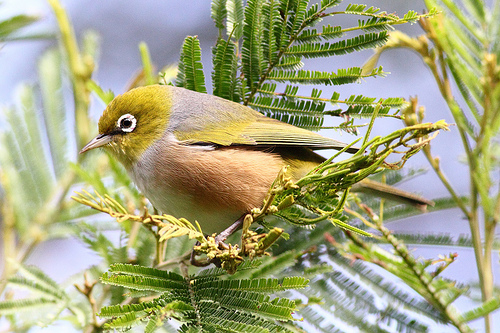
silvereye photo Frankzed
My garden is currently full of tiny birds, including flocks of silver-eyes, blue and red bellied wrens, finches and fantails. These birds are very tame, and in fact quite curious, if you move slowly and stand still for a while they come very close. The dense growth in the garden provides lots of places to hide, so these tiny birds feel quite safe, being able to disappear at a moment’s notice. Swallows have also returned to the garden and they fly incessantly above the pond in large figure eights.
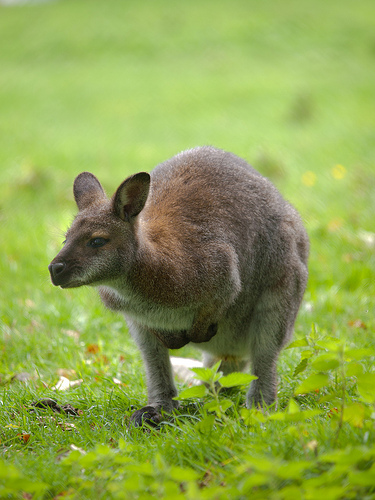
wallaby photo wwarby
Wildlife abounds in rural areas. Generally the drier winters encourage wildlife into the garden as the surrounding areas start to dry off and plant growth becomes less succulent. Bandicoots and bush turkeys are visiting the garden again and digging holes, scraping back bark mulch and dislodging the occasional plant. Wallabies have also returned. They love my blue couch lawn and keep it trimmed down between mowings. I occasionally see them, very early in the morning, motionless and clustered in a group, however the round black pellets across the grass are a dead give away of their nightly visits.
There are also many species of deer in my area. I disturbed a doe and fawn hiding among some bushes. They love to strip the bark from smaller shrubs and trees – in particular Euphorbia cottinifolia which I had understood was quite poisonous. This year I have seen many large stags and elegant does close to the road at night, however they generally prefer to reside in the valleys near creeks, rather than up on the hill where I live.
I am hoping that hares and wild pigs do not return to my garden this year, as they can do significant damage. The hares love to eat palm leaves, particularly Dypsis, and in a night will eat young palms down to the ground. The pigs love underground tubers and will destroy clumps of Alocasia and Xanthosoma. I hope that the predicted wet winter will provide enough food to encourage many of these animals to stay in the bushland areas.
Blazing away in my gardens are many Cordyline fruticosa cultivars. They are hardy, vigorous plants that deserve a place in any warm climate garden. Green cultivars can vary from monsters such as Cordyline ‘Green Giant’ to tiny little plants such as Cordyline ‘Green Imp’ which can be grown as a groundcover. More popular are the brightly coloured leaved cultivars and at this time of the year many of them simply blaze.
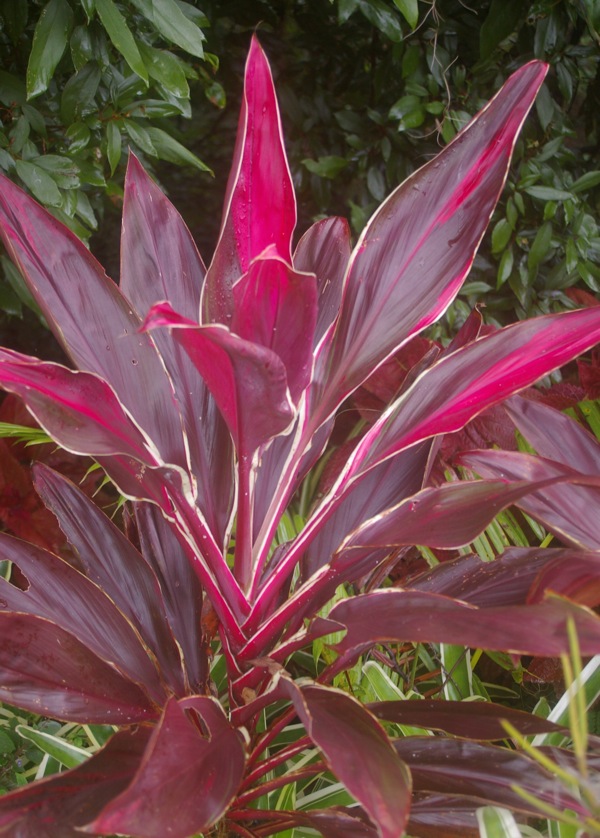 Cordylines are not for the faint hearted. Cordyline ‘Rubra’ increasingly has red flushing to its bronzy leaves. ‘Son Of’ has pure translucent crimson leaves. I wonder how it can photosynthesise. There is no sign of any chlorophyll. One of my personal favourites is Cordyline ‘Tartan’. It has a white edge to the leaf and petiole and a bronze leaf. However at this time of year the leaf is increasingly pink in colour.
Cordylines are not for the faint hearted. Cordyline ‘Rubra’ increasingly has red flushing to its bronzy leaves. ‘Son Of’ has pure translucent crimson leaves. I wonder how it can photosynthesise. There is no sign of any chlorophyll. One of my personal favourites is Cordyline ‘Tartan’. It has a white edge to the leaf and petiole and a bronze leaf. However at this time of year the leaf is increasingly pink in colour.
Cordyline ‘Peggy Garland’ graces another garden bed. I purchased this plant many years ago from Dennis Hundscheidt and it had sat in a pot in the shade house for some ten years, losing both its colour and its label. After two years, planted out in full sun, it no longer can be ignored. The very large, solid cream, young leaves gradually morph to pale pink and then to a feathered deep pink. Apparently this cultivar has become rather rare. I will be donating cuttings to the International Cordyline Society this summer so it can be propagated and dispersed to members and the general public.
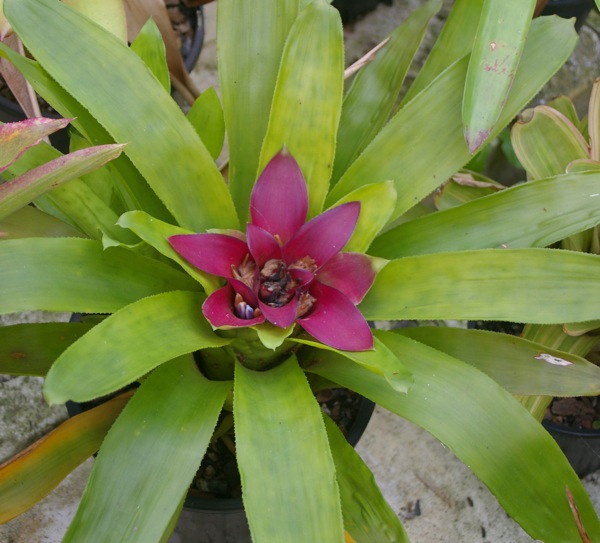
Nidularium antoinettianum in winter
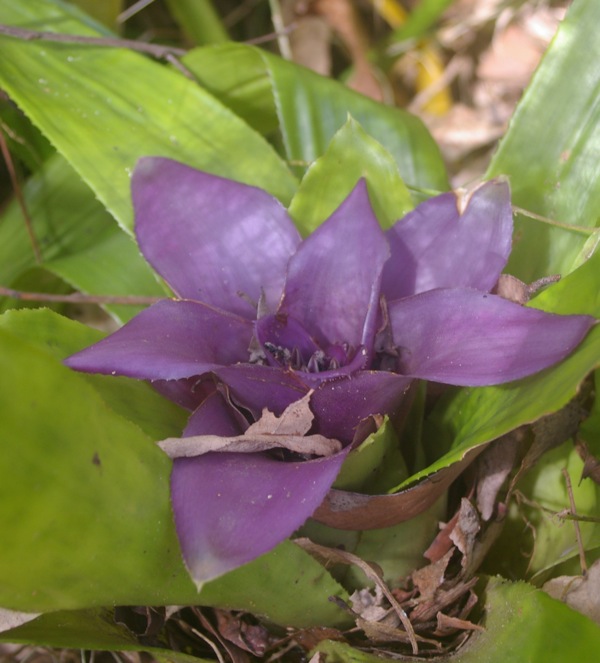
Nidularium antoinettianum in spring
Many bromeliads have come into flower over the last month. They are such hardy and pest resistant plants and require virtually no maintenance in the garden. Nidulariums are my favourites and grow so well in shady spots. The showy bracts that surround the flowers form a colourful nest within each rosette of leaves. Nidularium antoinettianum has just started its flowering season. It will continue for some 6 months, during which time the floral bracts will change from cerise to pink to lavender, purple and black.

Nidularium burlemarxii
Nidularium burlemarxii has a very different flower spike. It resembles a heliconia in shape. Currently a form with brownish orange bracts is in flower, however I also grow a form with yellow bracts.
Aechmea gamosepala is an old fashioned favourite in Queensland. Often referred to as the matchstick cactus, the flowers do look like pink, pale-blue tipped matches arranged along the pink stem. Flowering plants look amazing when mass planted. I am currently massing up stocks to create a large display. Also in flower are the cultivar Aechmea ‘Nivea’, which has white flowers, and the related species Aechmea kermeziana that has cream flowers.
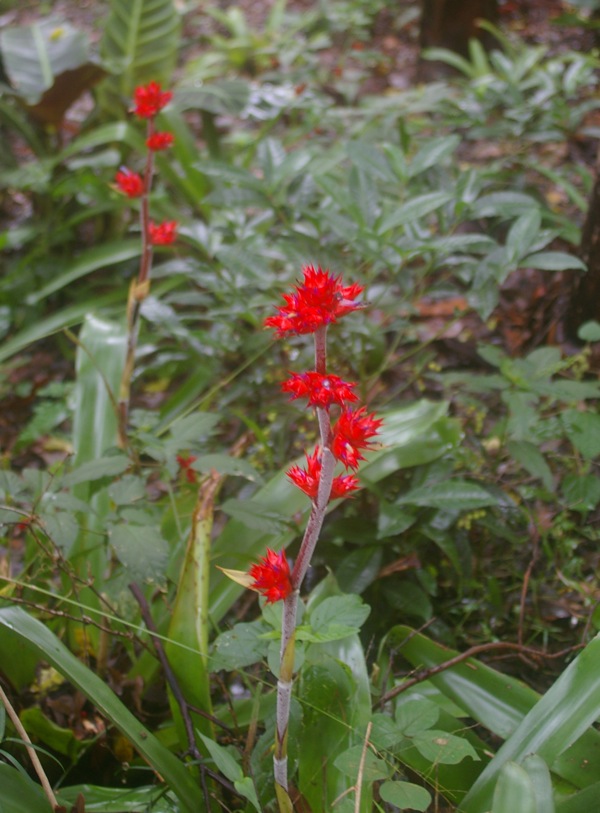
Hohenbergia stellata thrusts up its red flower spikes
Hohenbergia stellata has just started to throw up its inflorescences. The stem and bracts are a brilliant scarlet and are held vertically. They light up the area and contrast with the surrounding green foliage.
I also grow a number of variegated Alternanthera brasiliensis (sold as Alternanthera dentata) cultivars in my garden. As these plants come into flower this time of year, the adjacent foliage blazes with colour. Alternanthera ‘Firebug’ leaves are bronze, marbled with scarlet for much of the year but come winter, produce smaller solid red leaves. Alternanthera ‘Island Sunset’ generally has narrow bronze leaves with regular puce-pink margins. Once again the leaves become solid pink as the plant comes into flower. The deep crimson red bracts which surround white flowers provide colour from late autumn until early spring. While it can be pruned to size, this shrub looks best if given room to grow to full size – which is 2 to 2.5 metres high by 2.5 to 3 metres across.
A favourite Brisbane shrub is the Brazilian cloak, Megaskepasma erythrocalymus. It looks very exotic and very tender with its soft lush green leaves. However it is a very hardy shrub, growing in sun or semi-shade and tolerating long periods of dry weather. I use it as a backdrop to a garden bed and to provide some shelter from south-westerly winds. Although it can be pruned down to size, it looks best if allowed to grow to its natural size of 2.5m high and 2.5-3m across.
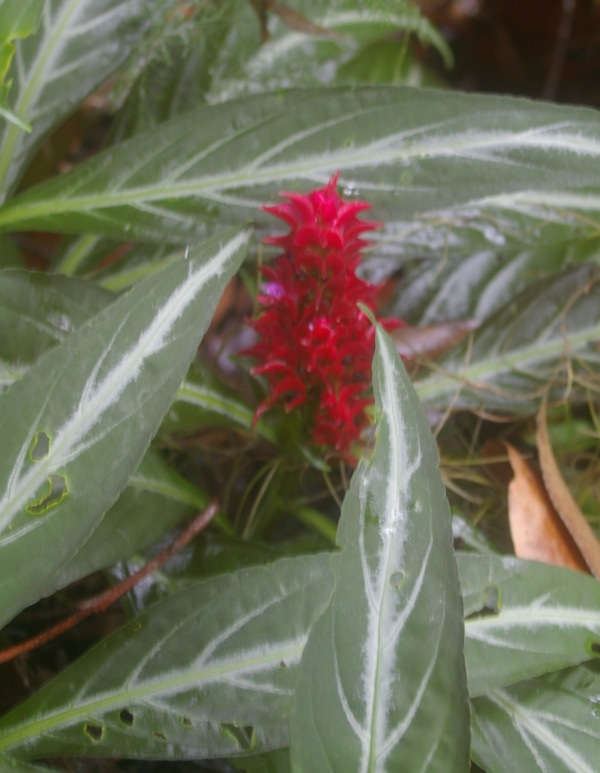
Porphyrocoma pohliana
A distant relative, also from Brazil, is the Brazilian fireworks plant, Porphyrocoma pohliana. It has attractive silvery white leaves which form a ground hugging rosette. During winter the red-bracted flower spikes studded with purple flowers appear.
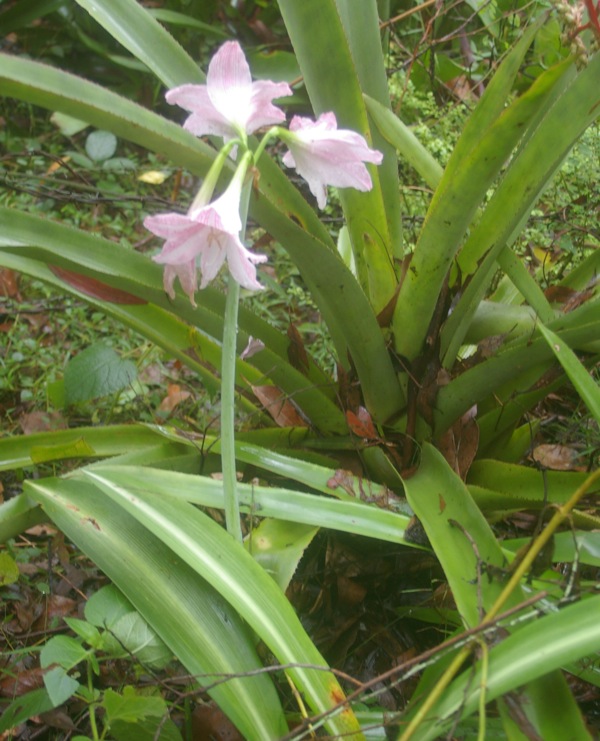
Hippeastrum ‘Mrs Garfield’
Two bulbs are in full flower, Haemanthus albiflorus with its yellow-tipped white pompoms of stamens and Hippeastrum ‘Mrs Garfield’. ‘Mrs Garfield’ is an 1862 hybrid of Hippeastrum reticulatum and Hippeastrum ‘Defiance’, which shares the ornamental white striped leaves of the former parent with the larger flowers of the latter parent. Both these bulbs seem to prefer a semi-shaded position in the garden.
Some things come and of course some things go. I have to say goodbye to some of my favourite summer- time plants. The Caladium have died down and many of the Curcuma are following. Some of the broader leafed Curcuma cultivars make quite a show – the leaves suffusing with brilliant yellow before collapsing. The leaves of the Siam tulips (Curcuma alismatifolia cultivars) hang on longer than most but finally turn yellow then brown before collapsing overnight. That old fashioned survivor, the variegated shampoo ginger (Zingiber zerumbet ‘Darceyi’), makes an inglorious departure. Leaves go brown and fall off the stem a little at a time and the plant looks shabby. Luckily it is in a less prominent position in the garden. With all these plants, I find the larger and healthier the clump, the shorter the dormancy period. While drought can trigger dormancy, cooler temperatures are the main stimulus in my garden and prompt a much faster response.
Out on the pond a native lotus, Nelumbo nucifera, is also about to depart for the winter months. Over the last few weeks the flowers haven’t opened fully and now the petals are falling as the flowers open, leaving bright orange pods. The large leaves held well above the water have now been replaced by smaller floating leaves. These will in turn will soon disappear. Luckily this only occurs for a short time in my garden. By late August new leaves will appear and by the second week in October I should have the first flowers. My plant is a cultivar from Townsville with rich warm-pink flowers and purplish new leaves. I have other cultivars in large tubs around the lawn. These generally make their departure earlier in the year, due no doubt to the smaller thermal mass of water.
Some water lilies have died down, however the dwarf blue waterlilies Nymphaea ‘Daubenyana’ and Nymphaea colorata, will continue flowering right through winter. They are both great plants for small tubs or bowls. ‘Evelyn Randig’ with its rich deep pink flowers is another waterlily which will continue to flower throughout the year in most subtropical areas.
Now that plant growth has slowed down, I will be focussing on the weeds. Over the warmer wetter months I try to focus on planting, as with no town water supply, I rely a lot on natural rainfall. Weed growth has been spectacular this year. The ground is still moist so I work away at one area at a time. Cobblers pegs (Bidens pilosa) and Thickhead (Crassocephalum crepiioides) in particular have grown profusely. It is good to know that they are both regarded as highly nutritious vegetables overseas. I am not going to starve!
